Safety Rules
- Never throw your boomerang at or to anyone
- Allow plenty of room for throwing. A large field or park is ideal
- Never throw your boomerang in gusty or windy conditions, particularly while at the learner stage.
(A still to mild day is ideal) - Never catch your boomerang at eye level. Always wait until it is below shoulder height
- Never throw your boomerang laid over flat like a frisbee. Always have the boomerang nearly vertical on release to avoid dangerous diving and swooping flights
- Don’t throw too hard at first. Half powered throws are enough to return most models. As you gain experience, you can add more power for longer range and flight duration
How To Hold ItThe curved or decorated side should be held towards you and the flat side away. The easiest way to grip it is to make a closed fist and insert the boomerang between the thumb and first finger. Make sure the boomerang is cocked back along your arm for maximum spin. The ´elbow´ section can be pointing either forward or back as shown. See which grip suits you best. |
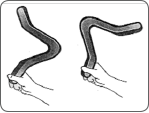 Grip with a closed fist... |
Throwing Your BoomerangThrow with a normal over arm style facing 45 degrees to the right of the wind (to the left if you are left handed). Aim the boomerang at a point on or just above the horizon. |
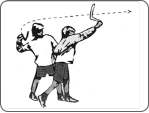 Throw overarm... |
Wind FactoringThrow to the right of the wind about 45 degrees (to the left if you are left handed) so that the breeze helps the boomerang come back. By throwing from the same spot each time and aiming for an object in the distance, you can adjust the throw angle to the wind. |
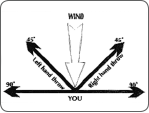
Consider wind conditions... |
Launch AngleThe boomerang should be nearly vertical on release. Increasing the tilt angle makes it fly highter and land further back. Holding it more vertically makes it fly lower and land further forward. Never throw it laid over flat. |
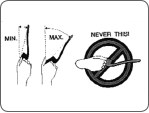
Release almost vertically... |
Catching the boomerangCatch it between your hands with a clapping motion as shown as it hovers down near you. Aim for the central section of the boomerang and avoid the fast moving wing tips. |
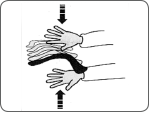 Aim for the central section... |
Tips For Improving Your ThrowIssue: Boomerang lands to your left or right instead of coming right back. |
|
